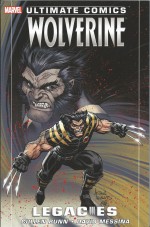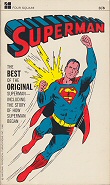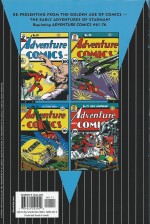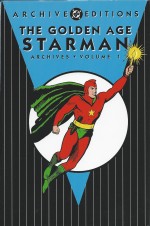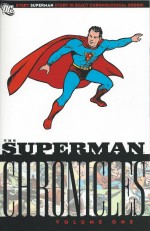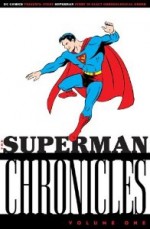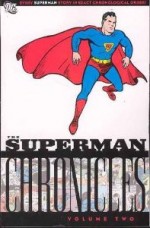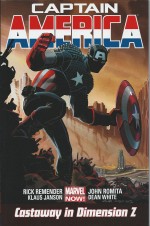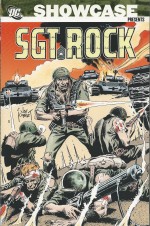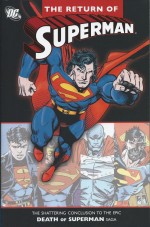
By Dan Jurgens, Karl Kesel, Jerry Ordway, Louise Simonson, Roger Stern & various (DC Comics)
ISBN: 978-2-56289-149-6
Although largely out of favour these days as all the myriad decades of Superman mythology are inexorably re-assimilated into one overarching all-inclusive multi-media Film-favoured DC continuity, the stripped-down, gritty post-Crisis on Infinite Earths Man of Steel as re-imagined by John Byrne, and marvellously built upon by a succession of immensely talented comics craftsmen, resulted in some genuine comics classics.
Most significant of them was a three-pronged story-arc which saw the martyrdom, loss, replacement and inevitable resurrection of the World’s Greatest Superhero in a stellar saga which broke all records and proved that a jaded general public still cared about the venerable, veteran icon of Truth, Justice and the American Way.
The dramatic events also provided a spectacular springboard for a resurgent burst of new characters who revitalised and reinvigorated more than one ailing franchise over the next decade…
This final landmark collection features material which originally appeared in Action Comics #687-691, Superman: the Man of Steel #22-26, Superman #78-82 and Adventures of Superman #500-505, plus Green Lantern volume 3 #46, spanning cover-dates June-October 1993 and originally published as the braided mega-saga “Reign of the Supermenâ€.
Written by Dan Jurgens, Karl Kesel, Louise Simonson & Roger Stern with art by Jon Bogdanove, Tom Grummett, Jackson Guice, Jurgens, Brett Breeding, Doug Hazlewood, Dennis Janke & Denis Rodier, it details the stunning events which led up to the resurrection and return of the one and only Man of Tomorrow – although just who that might be was the subject of much debate at the time…
After a brutal rampage across Middle America a mysterious monster dubbed Doomsday had only been stopped in the heart of Metropolis by an overwhelming and fatal effort on Superman’s part.
Dying at the scene, the fallen hero’s body was the subject of many legal battles before it was ostensibly laid to rest in a tomb in Metropolis’ Centennial Park. However as Earth adjusted to a World Without a Superman rumours began to circulate that, like Elvis, the Man of Tomorrow was not dead…
It all began with a series of teaser ‘First Sightings’ (from Adventures of Superman #500) as, across America, four very different individuals appeared, saving lives and performing good deeds as only the departed defender could.
Then events start to properly unfold in ‘Born Again’ (Action #687 by Stern, Guice & Rodier) as scientists in Antarctica experienced unnatural power manifestations whilst, deep below the polar crust in the Fortress of Solitude, a confused creature more energy than matter manifested.
The bizarre being remembered dying in battle against Doomsday and, after flicking across the world in an eye-blink to explore an empty tomb in Metropolis, it reasonably concluded he was Superman reborn through Kryptonian technology…
He was however much reduced and changed. Unable to covert solar radiation into strength, he was so painfully sensitive to light he had to wear a protective visor. This Man of Tomorrow only manipulated energy and, after returning to Metropolis to resume his “never-ending battle†against chaos and injustice, soon displayed a callous disregard for the humans he protected when he executed a rapist and crippled a car-jacker…
The “Dirty Harry with a cape†soon attracted the attention of apparently benevolent billionaire Lex Luthor II (actually the wicked original in a cloned body) and Supergirl, but received his most telling confirmation when he met Lois Lane and disclosed things only Clark Kent could know…
In Man of Steel #22, ordinary construction worker John Henry Irons – who had been saved by Superman in the past – felt compelled to carry on the hero’s mission and built a high-tech suit of armour to facilitate his crusade. ‘Steel’, by Simonson, Bogdanove & Janke, found the urban inventor cleaning up the streets of Metropolis and searching for a gang who used a deadly new form of super-gun dubbed “toastmasters†– a weapon Irons had designed in another life…
Tracking the munitions enabled him to save the life of a fortune-teller and brought him into savage conflict with White Rabbit – a new criminal major player in the city – but life only got more complicated the morning after, when Psychic Rosie went on TV claiming Steel was possessed by the unquiet soul of Superman…
Superman # 78 (by Jurgens & Breeding) offered another apparent pretender. ‘Alive’ saw a Superman grotesquely bonded with mechanical appendages raid the top-secret genetics lab Cadmus Project to take the comatose Doomsday from rogue Director Paul Westfield, before dispatching the deadly mystery monster into deep space where no Earthly agency could exploit it.
When the partially amnesiac Cyborg-Superman subsequently met Lois, her suspicions were shockingly quelled by the few facts he could recall: the name Kent, a farm in Kansas, his feelings for her…
And when she took him to see maverick inventor Emil Hamilton, the Action Ace’s personal scientific advisor pronounced the bionic additions to be Kryptonian machines whilst the fleshly parts of the modern Prometheus comprised Superman’s unique DNA…
The final contender for the S-shield cropped up in Adventures of Superman #501 as ‘…When He Was a Boy!’ by Kesel, Grummett & Hazlewood revealed the secret history of a brash and cocky kid who wore an adaptation of the Man of Tomorrow’s outfit and claimed to be a clone of the deceased hero, escaped from Cadmus.
After alienating everybody at the Daily Planet the horny, inexperienced juvenile latched onto ambitious journalist – and hottie – Tana Moon and fell under the spell of corrupt media mogul Vinnie Edge. Soon the kid was fighting crime live on TV to boost ratings…
As the world reeled from news that their defender was back, the fallen champion’s intimates and enemies were forced to wonder which – if any – of the newcomers was the real deal…
After hard-line hero Guy Gardner clashed with the visored energy Superman in Action #688, the former Green Lantern determined that the Kryptonian vigilante’s brutal treatment of offenders in ‘An Eye for an Eye’ (Stern, Guice & Rodier) proved that, even if he wasn’t exactly like the old guy, he was the kind of champion criminals deserved to meet.
In Man of Steel #22 (Simonson, Bogdanove & Janke), the spiritual successor of Superman barely survived an insidious ‘Ambush!’ Even with Toastmasters, street-gang the Sharks proved no match for Steel’s armoured might, but after a contentious clash of wills with the juvenile Krypton clone, Irons met White Rabbit and discovered she was an old flame from his Army weapons building days.
Caught off-guard he almost perished until “Don’t-call-me-Super BOY†flashed in to rescue him…
Jurgens & Breeding took an experimental tack in Superman #79 as Daily Planet reporter Ronald Troupe reviewed all the facts on the quartet of newcomers in ‘Prove It.’ After the Cyborg crusader spectacularly saved President Clinton from assassination he – and the Federal Government – could reach only one conclusion…
Meanwhile in Adventures of Superman #502, ‘Boy Meets Girl’ (Kesel, Grummett & Hazlewood) followed the impetuous clone as he clashed with – and perved over – Supergirl before tangling with hired gun Stinger, commissioned by Vinnie Edge to perk up the viewing figures whatever the collateral costs…
Action and mystery expanded exponentially in #689’s ‘Who is the True Hero?’ by Stern, Guice & Rodier. Metropolis reeled from the devastation caused by the clone’s clash with Stinger, with Supergirl and the horrified kid frantically saving survivors, whilst in the Antarctic Fortress a fifth Superman emerged from a Kryptonian regeneration matrix…
Although barely stronger than an ordinary human, the reborn Kal-El quickly began catching up on what had happened since his demise, courtesy of the battery of alien machines in the icy citadel…
Back in Metropolis the merciless avenging Superman cataclysmically clashed with his ethical opposite Steel with Lois and Jimmy Olsen utterly unable to calm them down.
The combat carried over into Man of Steel #23, but the furious heroes were blithely unaware that an horrific alien conqueror was approaching Earth in ‘Impact!’ by Simonson, Bogdanove & Janke. Also oblivious to the impending disaster, the forces of Luthor and White Rabbit bloodily battled for control of the city…
‘Deadly Alliance’ (Jurgens & Breeding) in Superman #80 found Earth’s authorities made too-suddenly aware of the alien intruder. They responded by sending the Caped Cyborg to intercept it.
En route the officially recognised hero joined forces with his energy-based alternate – only to kill him and allow 77,000 space mines to explosively erase Coast City and its seven million inhabitants from the face of the planet.
As the planet shuddered the invader was revealed as cosmic conqueror Mongul – but nobody on Earth knew he was simply a pawn and the devoted servant of the Cyborg…
The drama kicked into overdrive in Adventures of Superman #503, with ‘Line of Fire!’ (Kesel, Grummett & Hazlewood) showing the bionic betrayer eradicating survivors before luring the clone to ground zero and disposing of him as he had the Avenger, whilst in Antarctica the merely mortal Kal-El climbed into a Kryptonian war-suit and headed for the disaster zone…
‘Lies & Revelations’ (Action #690, by Stern, Guice & Rodier) saw the visored vigilante framed for the mass destruction by Cyborg Superman and Mogul as they sought to divert the attention of the Justice League and Earth’s other heroes.
The allies-in-atrocity had a plan and a timetable. Planning to raze Metropolis too, they would construct colossal world-moving engines in the craters and turn the planet into a War-World capable of dominating the galaxy and populated by the army of extraterrestrial soldiers they had amassed…
As Kal-El approached his hometown and the site of the next horrific Engine City, in Antarctica the swiftly-fading visored vigilante learned his true origins at last and, re-energised, headed back to the remains of Coast City…
Man of Steel #24 featured ‘The Return!’ (Simonson, Bogdanove & Janke) as Super-clone broke free and attempted to warn the world, even as Steel and Supergirl intercepted the war-suited warrior and discovered that the one true Metropolis Marvel was back …
Superman #81 ‘Resurrections’ (Jurgens & Breeding) revealed the secret origin of the Cyborg and his pact with Mongul, as Kal-El, Steel, Supergirl and the Superboy rocketed to California and a desperate ‘Assault on Engine City!’ (Adventures of Superman #504 Kesel, Grummett & Hazlewood)
It all culminated in a cross-continental chase and the clone kid seemingly sacrificing himself to destroy the city-smashing space-ordinance in the skies above Metropolis…
Action #691 revealed the heroes’ late-arriving and extremely angry ‘Secret Weapon’ (Stern, Guice & Rodier) just as the war in Engine City roared to a blockbusting climax, after which ‘Blast Off!’ (Man of Steel #25, Simonson, Bogdanove & Janke) saw Kal fall to the merciless fists of Mongul as John Henry used his own armoured body to wreck the heart of Engine City…
Such an epic storyline naturally had repercussions outside Superman continuity and Green Lantern #46 intersected with the ongoing epic. GL Hal Jordan was a Coast City native and his inability to save his home, family and friends shattered him. (In fact these events would lead to his becoming manic mad mass-murderer Parallax and destroying the entire Green Lantern Corps – but that’s a tale for another tome…)
Arriving in ‘Death City’ (by Gerard Jones, M.D. Bright & Romeo Tanghal) just as Mongul prepared to deliver a killing blow, the Emerald Avenger saved Kal before venting all his wrath on the genocidal monster.
This savage assault allowed the restored Caped Kryptonian to reclaim his name and save the world once again in Superman #82’s ‘Back for Good’ (Jurgens & Breeding)… but only after one of his well-meaning pretenders surrendered everything he was…
This Earth-shattering epic winds down with a brace of excepts designed to re-establish the natural order, beginning with the first two pages of ‘Reign of the Superman’ (from Adventures of Superman #505 by Kesel, Grummett & Hazlewood) as the one and only Superman at last returns to his grieving widow, before ‘Epilog: …And Who, Disguised as Clark Kent’ (from Action #692 courtesy of Stern, Guice & Rodier) clears up the last little details by “finding†the mild-mannered reporter in the subterranean basement he had been trapped in since Doomsday’s rampage through Metropolis months previously.
This powerful if ponderous epic perfectly embodies all the human drama and cosmic spectacle of the Superman mythology: evocative, tense, drenched in action and spilling over with great ideas and characters
This enthralling classic served as a valuable and necessary expansion of the legend, introducing a plethora of Supermen in a bold and long-term push to revitalise the venerable franchise, whilst the positively manic public interest beyond the world of comics took everyone by surprise and made the Man of Tomorrow as vital and vibrant a sensation as he was in the earliest days of his creation.
Best of all, it looks beautiful and reads great.
Together with the previous two volumes in this truly magnificent triptych, this saga is possibly the greatest Superman story ever told. What more do you need to know?
© 1993 DC Comics, Inc. All Rights Reserved.


